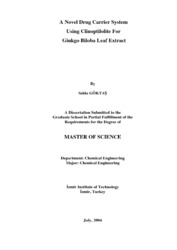Please use this identifier to cite or link to this item:
https://hdl.handle.net/11147/3390Full metadata record
| DC Field | Value | Language |
|---|---|---|
| dc.contributor.advisor | Ülkü, Semra | - |
| dc.contributor.author | Göktaş, Selda | - |
| dc.date.accessioned | 2014-07-22T13:51:26Z | - |
| dc.date.available | 2014-07-22T13:51:26Z | - |
| dc.date.issued | 2004 | - |
| dc.identifier.uri | http://hdl.handle.net/11147/3390 | - |
| dc.description | Thesis(Master)--Izmir Institute of Technology, Chemical Engineering, Izmir, 2004 | en_US |
| dc.description | Includes bibliographical references (leaves: 78) | en_US |
| dc.description | Text in English; Abstract: Turkish and English | en_US |
| dc.description | xiv, 96 leaves | en_US |
| dc.description.abstract | The use of natural and synthetic zeolites for pharmacological applications in possible encapsulation and/or adsorption of different ions and molecules in their open frame-work, and the subsequent release has emerged as a promising field during last years. In this study, the possible use of clinoptilolite-rich mineral as a novel drug carrierfor the active constituents present in Ginkgo biloba leaf extract solutions was investigated.In the first place, the extraction conditions for the compounds of interest (terpene lactones and flavonoid aglycones) within the leaf material were optimized. The extraction processes were performed with 80% ethanol aqueous solution due to its being non-toxic in nature and widely-used solvent for the preservation of the antioxidant activity possessed by the extract. For the quantification of the extracted species, HighPerformance Liquid Chromatography (HPLC) analysis was conducted. The quantification of terpene lactones was achieved with Evaporative Light Scattering Detection (ELSD), whereas flavonoid glycosides were quantified by Ultraviolet (UV) detection after being converted to their aglycone forms via acidic hydrolysis.In the adsorption studies, clinoptilolite having a particle size in the range 25- 106um was experimented. The flavonoid aglycone constituents were found to be selectively adsorbed on the clinoptilolite surface, whereas terpene lactones were determined to be adsorbed on the clinoptilolite surface in negligible amount. Therefore, the study concentrated on the adsorption of flavonoid constituents on the surface of the zeolitic material.Finally, the antioxidant activity determinations of the extract solutions were performed by the Trolox Equivalent Antioxidant Capacity (TEAC) assay. The antioxidant activity measurements performed for the Ginkgo leaf extract and commercial tablet extract solutions both showed decreasing antioxidant activities via adsorption. The decrease in antioxidant activity was related to the adsorption of phenolic constituents on the clinoptilolite surface. | en_US |
| dc.language.iso | en | en_US |
| dc.publisher | Izmir Institute of Technology | en_US |
| dc.rights | info:eu-repo/semantics/openAccess | en_US |
| dc.subject.lcc | QK494.5.G48 .G61 2004 | en |
| dc.subject.lcsh | Ginkgo | en |
| dc.title | A novel drug carrier system using clinoptilolite for ginkgo biloba leaf extract | en_US |
| dc.type | Master Thesis | en_US |
| dc.institutionauthor | Göktaş, Selda | - |
| dc.department | Thesis (Master)--İzmir Institute of Technology, Chemical Engineering | en_US |
| dc.relation.publicationcategory | Tez | en_US |
| dc.identifier.wosquality | N/A | - |
| dc.identifier.scopusquality | N/A | - |
| item.openairecristype | http://purl.org/coar/resource_type/c_18cf | - |
| item.cerifentitytype | Publications | - |
| item.fulltext | With Fulltext | - |
| item.languageiso639-1 | en | - |
| item.grantfulltext | open | - |
| item.openairetype | Master Thesis | - |
| Appears in Collections: | Master Degree / Yüksek Lisans Tezleri | |
Files in This Item:
| File | Description | Size | Format | |
|---|---|---|---|---|
| T000511.pdf | MasterThesis | 4.42 MB | Adobe PDF |  View/Open |
CORE Recommender
Page view(s)
204
checked on Apr 28, 2025
Download(s)
92
checked on Apr 28, 2025
Google ScholarTM
Check
Items in GCRIS Repository are protected by copyright, with all rights reserved, unless otherwise indicated.